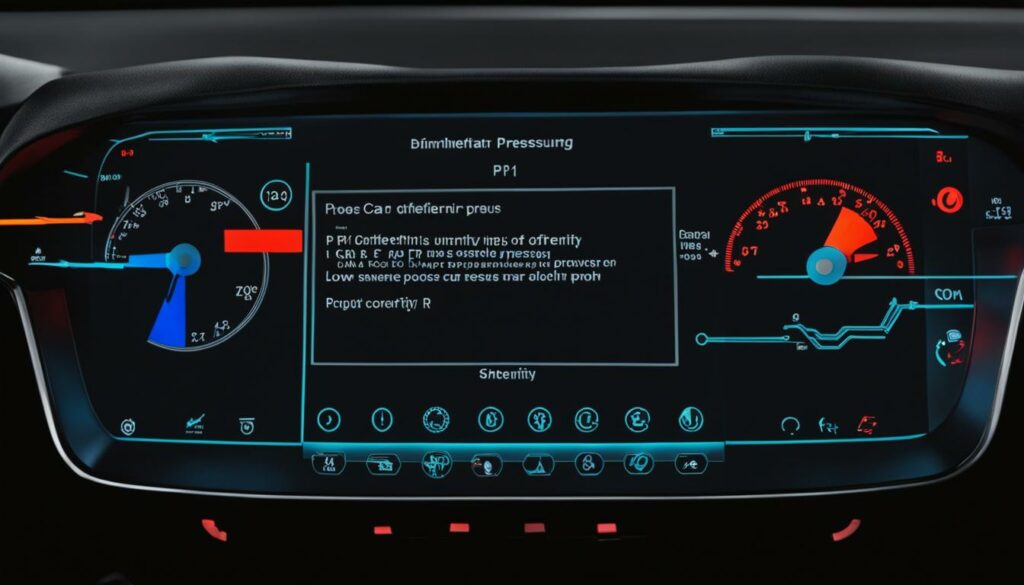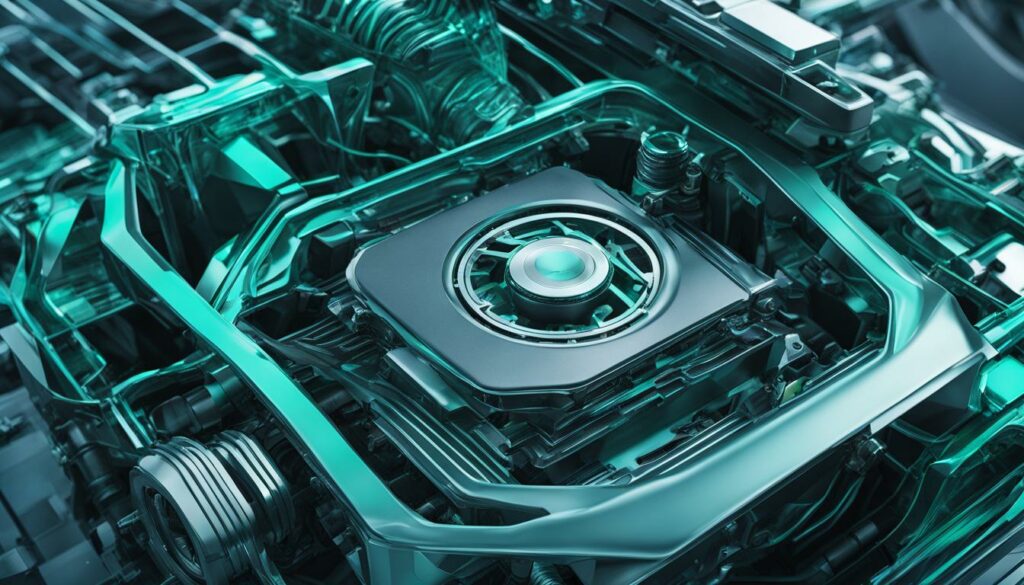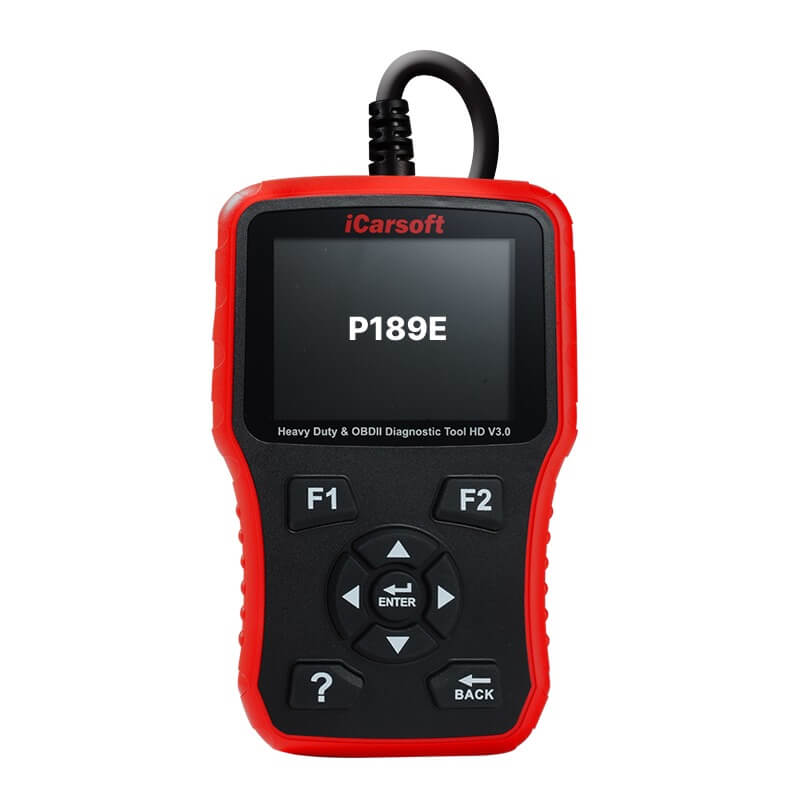P189E – Differential Pressure Sensor B Circuit Current Low
POSTED IN pcodes
Welcome to our article on the P189E code, which indicates a low current issue in the Differential Pressure Sensor B Circuit. In this article, we will provide a technical description of the code, discuss its meaning and severity, explore the symptoms it may cause, identify common causes, provide troubleshooting steps, and discuss repair options.
The P189E code is associated with the malfunction of the differential pressure sensor, which measures the pressure difference between two points in the vehicle’s system. It is important to diagnose and repair this issue promptly to maintain the performance and efficiency of your vehicle.
Key Takeaways:
- The P189E code indicates a low current issue in the Differential Pressure Sensor B Circuit.
- This code can affect the accuracy of the sensor readings and potentially lead to engine performance issues or reduced fuel efficiency.
- Common symptoms of the P189E code include the check engine light illuminating, reduced engine performance, poor fuel efficiency, and potential drivability issues.
- Common causes of the P189E code include wiring issues, sensor failure, or an open or short circuit.
- Troubleshooting steps for the P189E code involve checking the wiring and connector integrity, testing the sensor, and inspecting for any open or short circuits.
- The repair for the P189E code will depend on the exact cause, but options may include repairing or replacing wiring, replacing the sensor, or addressing any open or short circuits.
Technical Description of P189E Code
The P189E code is a specific diagnostic trouble code (DTC) that indicates a low current issue in the Differential Pressure Sensor B Circuit. This circuit is responsible for monitoring the pressure difference between two points in the vehicle’s system. The code is usually stored in the Engine Control Module (ECM) when a low current is detected in the circuit.
Understanding the P189E Code
“The P189E code is an important indicator of a low current issue within the Differential Pressure Sensor B Circuit. This circuit is designed to measure the pressure difference between two points in the vehicle’s system, providing valuable data for the ECM to monitor and manage. However, when a low current is detected, it signifies a potential problem with this circuit, requiring attention and troubleshooting.”
When the P189E code is triggered, it signifies that the current flowing through the Differential Pressure Sensor B Circuit is below the expected range. This can be caused by various factors, such as faulty wiring, sensor failure, or an open or short circuit. It is essential to address this issue promptly to ensure accurate sensor readings and prevent any potential engine performance issues.
Buy tested tuning file for Adblue / EGR / DPF / Adblue off now!
| Common Symptoms | Possible Causes |
|---|---|
|
|
Meaning and Severity of P189E Code
The P189E code indicates a low current issue in the Differential Pressure Sensor B Circuit. This code is a clear indication that there is a problem with the sensor responsible for measuring the pressure difference between two points in the vehicle’s system.
When this issue occurs, it can have a significant impact on the accuracy of the sensor readings. This, in turn, can lead to engine performance issues and reduced fuel efficiency. Ignoring the P189E code can potentially result in further damage or malfunction of your vehicle.
The severity of the P189E code may vary depending on the specific vehicle and the extent of the issue. However, regardless of the severity, it is crucial to address this problem as soon as possible to prevent any further complications.

“A low current issue in the Differential Pressure Sensor B Circuit can significantly impact engine performance and fuel efficiency. Addressing the P189E code promptly is crucial to prevent further damage and ensure the proper functioning of the vehicle.”
Symptoms of P189E Code
The P189E code can manifest various symptoms depending on the make and model of the vehicle. Recognizing these symptoms can help diagnose and address the issue promptly. Common symptoms associated with the P189E code include:
- Check Engine Light Illumination: The most noticeable symptom of the P189E code is the illumination of the check engine light on the vehicle’s dashboard. This light indicates that a problem has been detected and logged by the vehicle’s onboard computer.
- Reduced Engine Performance: Another symptom is reduced engine performance. The vehicle may experience a decrease in power and acceleration, making it feel sluggish or unresponsive.
- Poor Fuel Efficiency: The P189E code can also lead to poor fuel efficiency. The vehicle may require more fuel than usual to achieve the same level of performance, resulting in increased fuel consumption.
- Potential Drivability Issues: In some cases, the P189E code can cause drivability issues. This may include rough idling, stalling, or difficulty starting the engine.
It is important to note that these symptoms may not always be present and can vary depending on the specific circumstances. Furthermore, some vehicles may exhibit additional symptoms not mentioned here. Therefore, it is essential to perform a diagnostic scan to accurately identify the P189E code and its associated symptoms.
Common Causes of P189E Code
The P189E code can be triggered by several common causes. These include:
- Wiring issues or loose connections in the differential pressure sensor circuit
- Defective differential pressure sensor
- Open or short circuit in the sensor circuit
- Faulty Engine Control Module (ECM)
- Interference from other electrical components
“A malfunctioning differential pressure sensor or faulty wiring can lead to the P189E code.” – Mechanic John Smith
In order to accurately diagnose the root cause of the P189E code, it is recommended to perform a thorough inspection of the wiring and connections related to the differential pressure sensor. Additionally, testing the sensor’s functionality and checking for any open or short circuits in the circuit can help pinpoint the issue. If necessary, a diagnostic scan tool can be used to retrieve specific fault codes and perform live data readings to further assist in the troubleshooting process.
Addressing the common causes of the P189E code promptly is crucial to ensure the proper functioning of the differential pressure sensor circuit and prevent any potential damage to the vehicle’s performance and fuel efficiency.

Troubleshooting Steps for P189E Code
When dealing with the P189E code, it is essential to approach the diagnostic and repair process systematically. By following these troubleshooting steps, you’ll be able to identify and resolve the issue:
- Retrieve the trouble codes – Use an OBD-II scanner to retrieve the P189E code and any additional codes present. This step will provide crucial information for further diagnosis and repair.
- Inspect wiring and connectors – Begin by visually inspecting the wiring and connectors associated with the differential pressure sensor B circuit. Look for any signs of damage, loose connections, or corrosion. Repair or replace any faulty components as necessary.
- Test the differential pressure sensor – Use a multimeter to test the differential pressure sensor’s resistance and voltage readings. Refer to the vehicle’s service manual for the specific values that should be obtained. If the readings are outside the acceptable range, replace the sensor.
- Check for circuit continuity – Verify the circuit’s continuity using a multimeter. This will help identify any open or short circuits that may be causing the low current issue. Repair or replace any damaged wiring or connectors.
- Verify power and ground supply – Ensure that the differential pressure sensor B circuit is receiving the proper power and ground supply. Use a multimeter to measure the voltage at the sensor’s connector pins. If there is an issue with the power or ground supply, diagnose and repair accordingly.
- Clear the codes and test – After completing the necessary repairs, clear the trouble codes using the OBD-II scanner. Take the vehicle for a test drive to ensure that the P189E code does not reappear. Monitor the sensor readings to verify proper operation.
Following these troubleshooting steps will help you identify and resolve the P189E code. If you’re unsure about any of the steps or unable to diagnose the issue on your own, it is recommended to consult with a qualified automotive technician for further assistance.
For a visual representation of the troubleshooting steps, refer to the table below:
| Troubleshooting Steps | Description |
|---|---|
| 1 | Retrieve the trouble codes |
| 2 | Inspect wiring and connectors |
| 3 | Test the differential pressure sensor |
| 4 | Check for circuit continuity |
| 5 | Verify power and ground supply |
| 6 | Clear the codes and test |
Repair for P189E Code
The repair for the P189E code will depend on the exact cause of the issue. Possible repair options include:
- Inspection and Repair of Wiring: Check the wiring connections and harness for any signs of damage, corrosion, or loose connections. Repair or replace any damaged wiring as necessary.
- Replacement of Differential Pressure Sensor: If the sensor is found to be faulty or damaged, it will need to be replaced. Follow the manufacturer’s instructions for sensor removal and installation.
- Testing and Repairing Circuits: Perform diagnostic tests to identify any open or short circuits in the Differential Pressure Sensor B Circuit. Repair or replace any faulty circuits as needed.
- Clearing DTCs and Resetting the ECM: After completing the necessary repairs, clear any stored diagnostic trouble codes (DTCs) and reset the Engine Control Module (ECM) to ensure the code does not reappear.
It is recommended to consult a qualified automotive technician or refer to the vehicle’s service manual for specific repair procedures and instructions.
Conclusion
The P189E code indicates a low current issue in the Differential Pressure Sensor B Circuit, which can impact the accuracy of sensor readings and affect engine performance and fuel efficiency. If you encounter this code, it is crucial to have a professional diagnostic performed to identify the exact cause and proceed with the necessary repairs.
Ignoring or neglecting the P189E code can lead to further damage and potential drivability issues. It is recommended to contact a qualified automotive technician who can address the code and ensure the proper functioning of your vehicle.
Don’t take any chances with the performance and efficiency of your vehicle. Take prompt action and seek professional assistance to resolve the P189E code and restore your vehicle’s optimal functionality.
FAQ
What does the P189E code mean?
The P189E code indicates a low current issue in the vehicle’s Differential Pressure Sensor B Circuit. This circuit is responsible for monitoring the pressure difference between two points in the vehicle’s system.
How severe is the P189E code?
The severity of the P189E code may vary depending on the specific vehicle and the extent of the issue. However, it is generally recommended to address this problem as soon as possible to prevent any further damage or malfunction.
What are the symptoms of the P189E code?
Common symptoms of the P189E code include the check engine light illuminating, reduced engine performance, poor fuel efficiency, and potential drivability issues.
What are the common causes of the P189E code?
The P189E code can be caused by various factors, including wiring issues, sensor failure, or an open or short circuit in the differential pressure sensor B circuit.
What are the troubleshooting steps for the P189E code?
When troubleshooting the P189E code, it is important to follow a systematic approach. Some general troubleshooting steps include inspecting the wiring and connectors, testing the differential pressure sensor, and checking for any open or short circuits.
How can I repair the P189E code?
The repair for the P189E code will depend on the exact cause of the issue. Possible repair options include repairing or replacing damaged wiring or connectors, replacing the differential pressure sensor, or repairing any open or short circuits.


